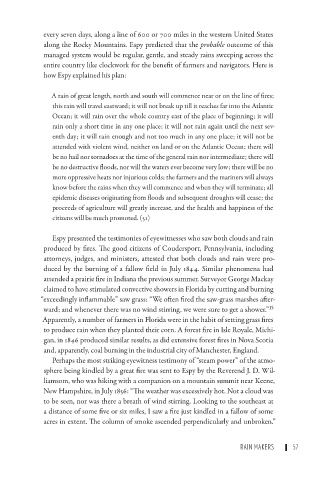Page 74 - James Rodger Fleming - Fixing the sky
P. 74
every seven days, along a line of 600 or 700 miles in the western United States
along the Rocky Mountains. Espy predicted that the probable outcome of this
managed system would be regular, gentle, and steady rains sweeping across the
entire country like clockwork for the benefit of farmers and navigators. Here is
how Espy explained his plan:
A rain of great length, north and south will commence near or on the line of fires;
this rain will travel eastward; it will not break up till it reaches far into the Atlantic
ocean; it will rain over the whole country east of the place of beginning; it will
rain only a short time in any one place; it will not rain again until the next sev-
enth day; it will rain enough and not too much in any one place; it will not be
attended with violent wind, neither on land or on the Atlantic ocean; there will
be no hail nor tornadoes at the time of the general rain nor intermediate; there will
be no destructive floods, nor will the waters ever become very low; there will be no
more oppressive heats nor injurious colds; the farmers and the mariners will always
know before the rains when they will commence and when they will terminate; all
epidemic diseases originating from floods and subsequent droughts will cease; the
proceeds of agriculture will greatly increase, and the health and happiness of the
citizens will be much promoted. (51)
Espy presented the testimonies of eyewitnesses who saw both clouds and rain
produced by fires. The good citizens of Coudersport, Pennsylvania, including
attorneys, judges, and ministers, attested that both clouds and rain were pro-
duced by the burning of a fallow field in July 1844. Similar phenomena had
attended a prairie fire in Indiana the previous summer. Surveyor George Mackay
claimed to have stimulated convective showers in Florida by cutting and burning
“exceedingly inflammable” saw grass: “We often fired the saw-grass marshes after-
15
ward; and whenever there was no wind stirring, we were sure to get a shower.”
Apparently, a number of farmers in Florida were in the habit of setting grass fires
to produce rain when they planted their corn. A forest fire in Isle Royale, Michi-
gan, in 1846 produced similar results, as did extensive forest fires in Nova Scotia
and, apparently, coal burning in the industrial city of Manchester, England.
Perhaps the most striking eyewitness testimony of “steam power” of the atmo-
sphere being kindled by a great fire was sent to Espy by the Reverend J. D. Wil-
liamsom, who was hiking with a companion on a mountain summit near Keene,
New Hampshire, in July 1856: “The weather was excessively hot. Not a cloud was
to be seen, nor was there a breath of wind stirring. Looking to the southeast at
a distance of some five or six miles, I saw a fire just kindled in a fallow of some
acres in extent. The column of smoke ascended perpendicularly and unbroken.”
rain makerS | 57

